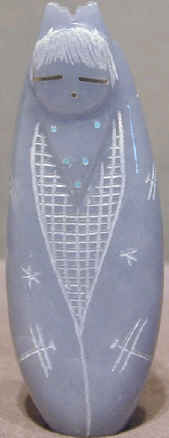(
Fr- anhydrite; Ger- Anhydrit;
Nor- anhydritt; Rus- ![]() )
)
ANHYDRITE, CaSO4.

Anhydrite (var. angelite). "Corn Maiden" (height - ca. 7.5 cm) carved by Zuni artist, Todd Westika. This fetish includes a five-piece turquoise "necklace" and silver to mark its facial features. The "Corn Maiden" is a mythical figure said to have saved the Zuni from starvation by providing the seeds that were planted to grow the corn crop that led to their survival. (© photo by Laurie McManis, Grey Dog Trading Co., Tucson, Arizona, www.greydogtrading.com)
DESCRIPTION:
Colors - white when pure, reddish, yellowish,
bluish, purplish, mauve, brownish or gray
H. 3½
S.G. ~ 2.95
Light transmission - translucent
Luster - pearly to vitreous luster
Breakage - tends to be brittle
Miscellany - soluble in warm HCl;
slightly hygroscopic; some anhydrite
fluoresces under ultra-violet radiation.
OTHER NAMES: Rock anhydrite, anhydrite rock or even anhydrock are geologically acceptable names for large masses of anhydrite, as distinct from anhydrite crystals. Some rock anhydrite comprises mappable units that have been given formal stratigraphic unit designations (see Appendix B, Glossary). Two examples are the Ferry Lake Anhydrite of the Gulf (of Mexico) Coast basin sedimentary sequence and the Potlatch Anhydrite of western Montana.
Massive anydrite used as a gemrock has been called by the following names:
USES: Anhydrite
ranging from snow-white to mauve has been carved and sculpted.
Angelite, the lilac- (or periwinke-, if you prefer) blue variety of
anhydrite has been fashioned and marketed widely as beads, both plain
and faceted; pendants of diverse shapes including
free-forms; fetishes (see illustration); "healing ..." and worry
stones; spheres,
pyramids and hearts; decorative slices; etc.; etc. Vulpinite has been cut and polished and marketed as
cabochons and diverse, typically relatively small, ornaments.
OCCURRENCES: Anhydrite has several diverse occurrences. Examples are: 1.extensive beds, commonly interstratified with rock gypsum, rock salt, limestone, and dolostone; 2.botryoidal masses and/or crystals in fissures where the anhydrite and associated minerals are usually thought to have been deposited by ground water; [and] 3.irregularly shaped masses, some of which are nodular (see under next subheading), in arid environments.
NOTEWORTHY LOCALITIES: Anhydrite, not otherwise described occurs at many places throughout the world. Exampes are: the Stassfurt deposits, Magdeburg, Germany; salt mines near Krako'w, Poland; mines and quarries in Hants, Cape Breton and Victoria counties of the northern mainland and Cape Breton Island of Nova Scotia, Canada; [and] several localities in the United States, many of which are noted in the publications listed under the REFERENCES subheading. The angelite variety of anhydrite, which is widely marketed as from Peru, is apparently recovered from chalky coated nodules from Peru's coastal lowland that is a so-to-speak northern extension of Chile's Atacama Desert. And, the angelite that consists of socalled fans of mutiple crystals is from silver mines of Naica, near Saucillo, Chihuahua, Mexico.
REMARKS: The name anhydrite, based
on the Greek ἄν-υδροϛ,
meaning without water -- i.e.,
anhyr(ous) + ite -- was
apparently given to direct attention to the difference between it and
gypsum, which is chemically similar but
hydrated. As noted in Palache, Berman and Frondel (1951):
"Anhydrite was first recognized as a separate species by Nicolaus Poda
von Neuhaus (1723-1728), Jesuit, although erroneously as a hydrated
chloride of calcium ... [who gave it] the name muriacite."
And it was not until 1804, some nine years after Klaproth determined
its true composition, when A.G. Werner named it anhydrit and listed the
type locality as the salt deposit at Hall, which is near Innsbruck,
Tyrol, Austria.
Anhydrite can
be dyed; indeed, I have been told that some angelite may be white
or gray anhydrite that has been dyed blue. So far as fashioning
any thing from anhydrite, lapidaries and sulptors should ever keep in
mind the fact that anhydrite is slightly hygroscopic -- i.e., "spare the water (and other
fluids)!". Also, it is reported that both the blue and
violet color of some anhydrite are markedly paled by treatments
involving heat; but, it is also said that the original colors can
be restored by irradiation.
There is a widespread so-to-speak reciprocal
relationship between rock anhydrite and rock gypsum: Some beds of
anhydrite appear to have formed by dehydration of rock gypsum; some
rock gypsum has apparently had anhydrite rock as a precursor. So
far as the anhydrite in marine evaporite deposits, Smith et al.
(1973, p. 205) note, "Gypsum normally predominates over anhydrite at or
near the surface and grades into anhydrite at depths ranging from a few
feet to a few hundred feet."
SIMULANTS: None that I have seen or seen described.
REFERENCES: Johnson, Gonzales and Dean, 1989; Smith et al., 1973; Withington, 1962; Withington and Jaster, 1960.
R. V. Dietrich © 2015
Last
update: 16 July
2005
web page created by Emmett Mason